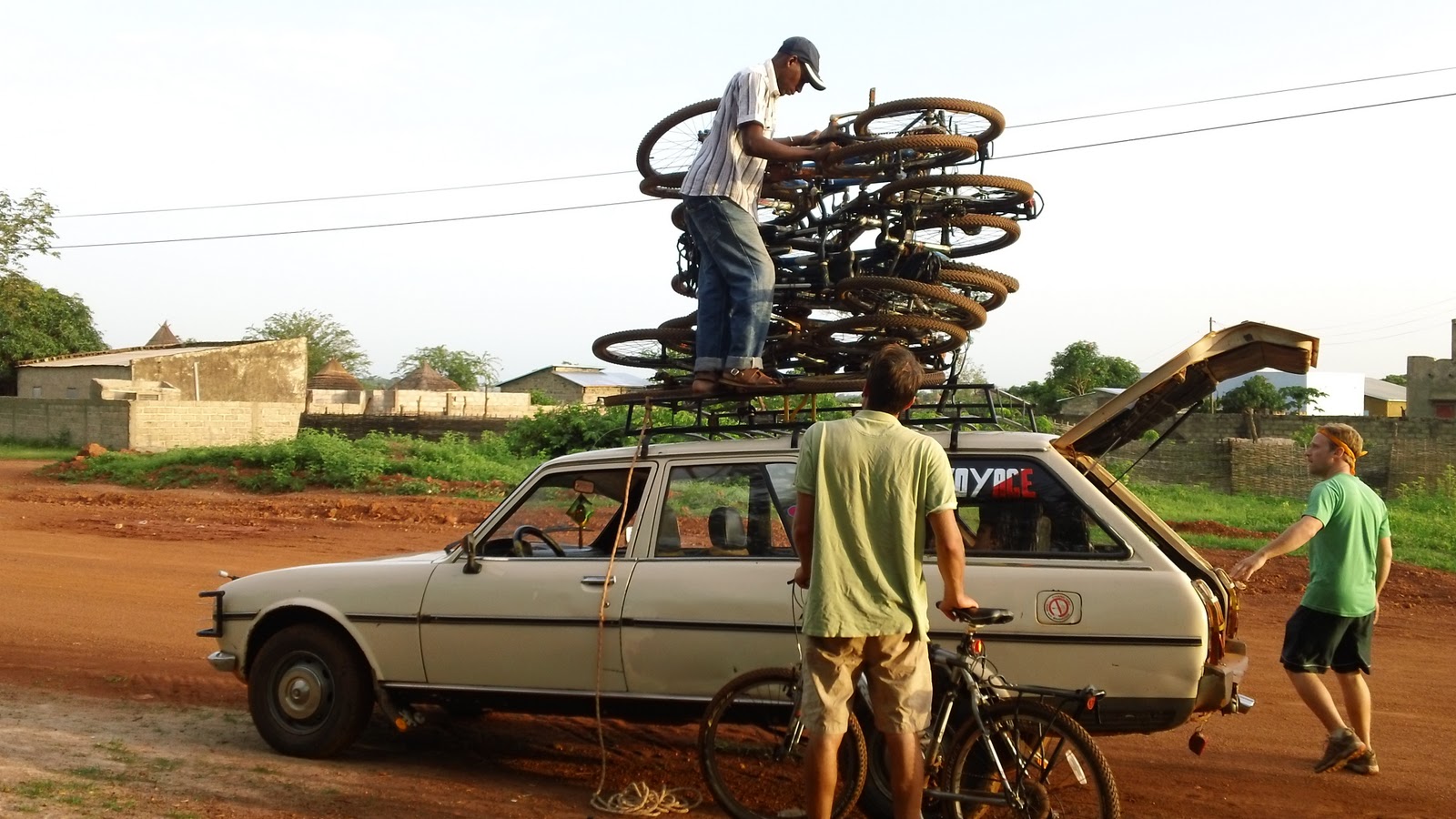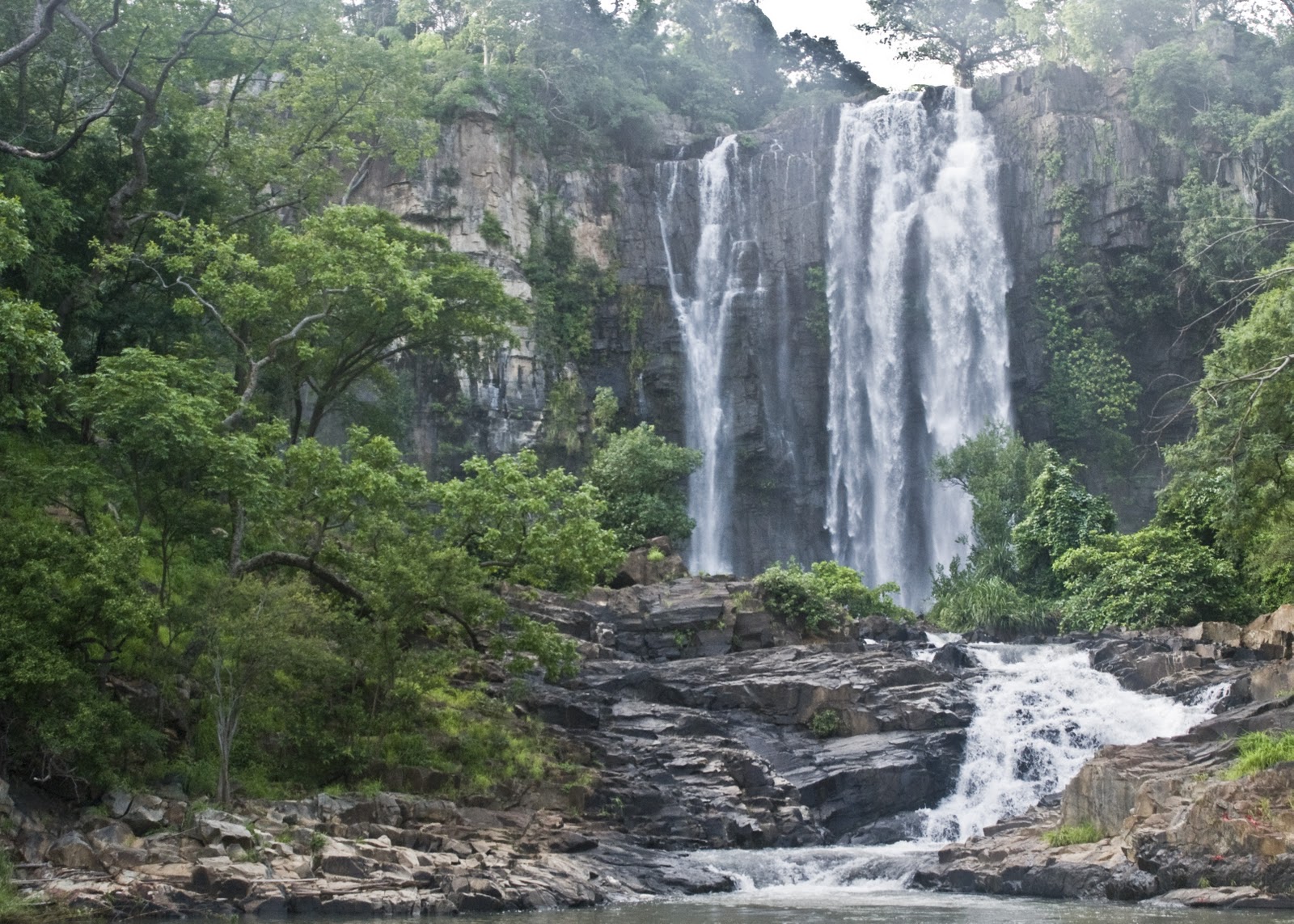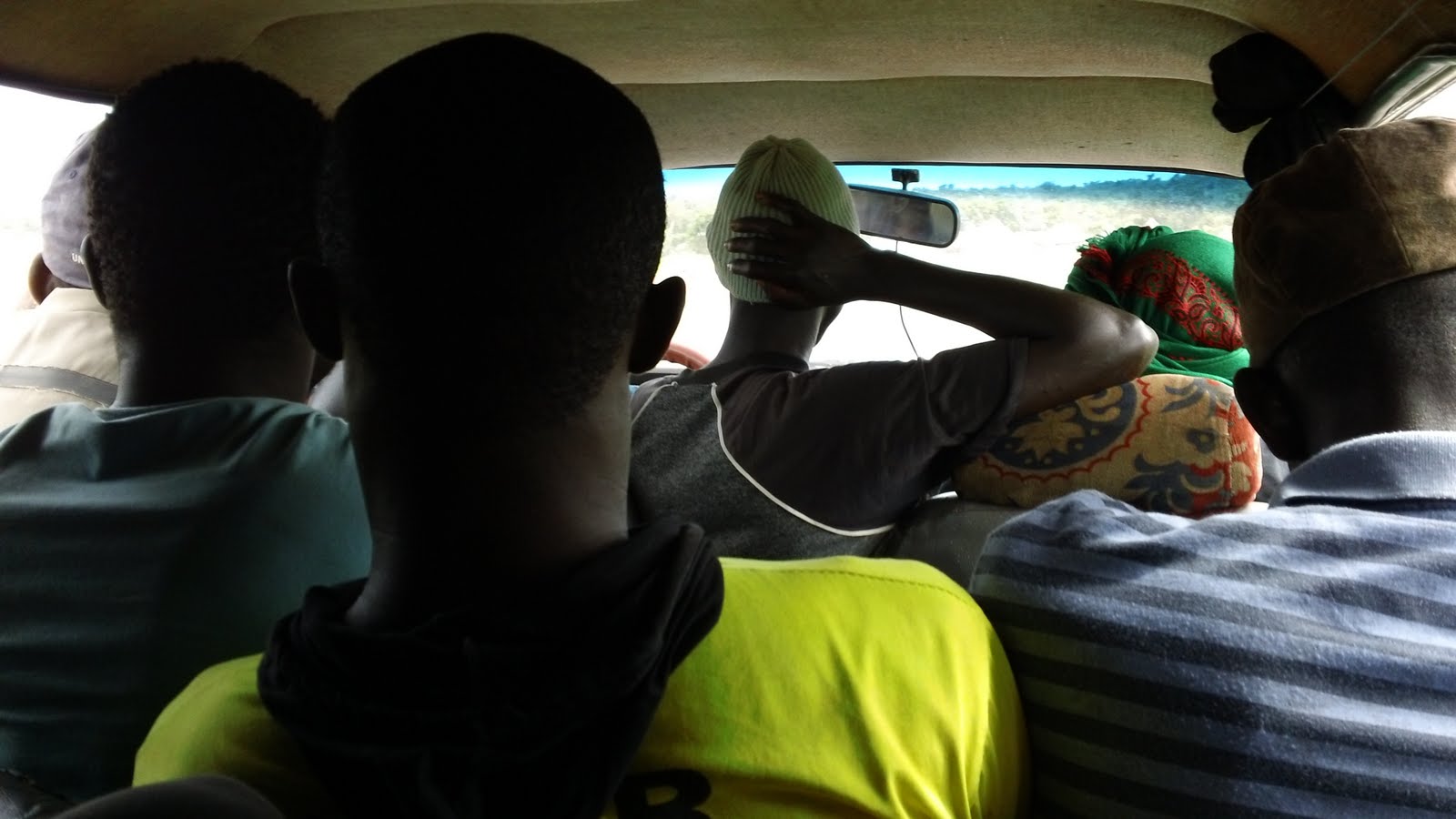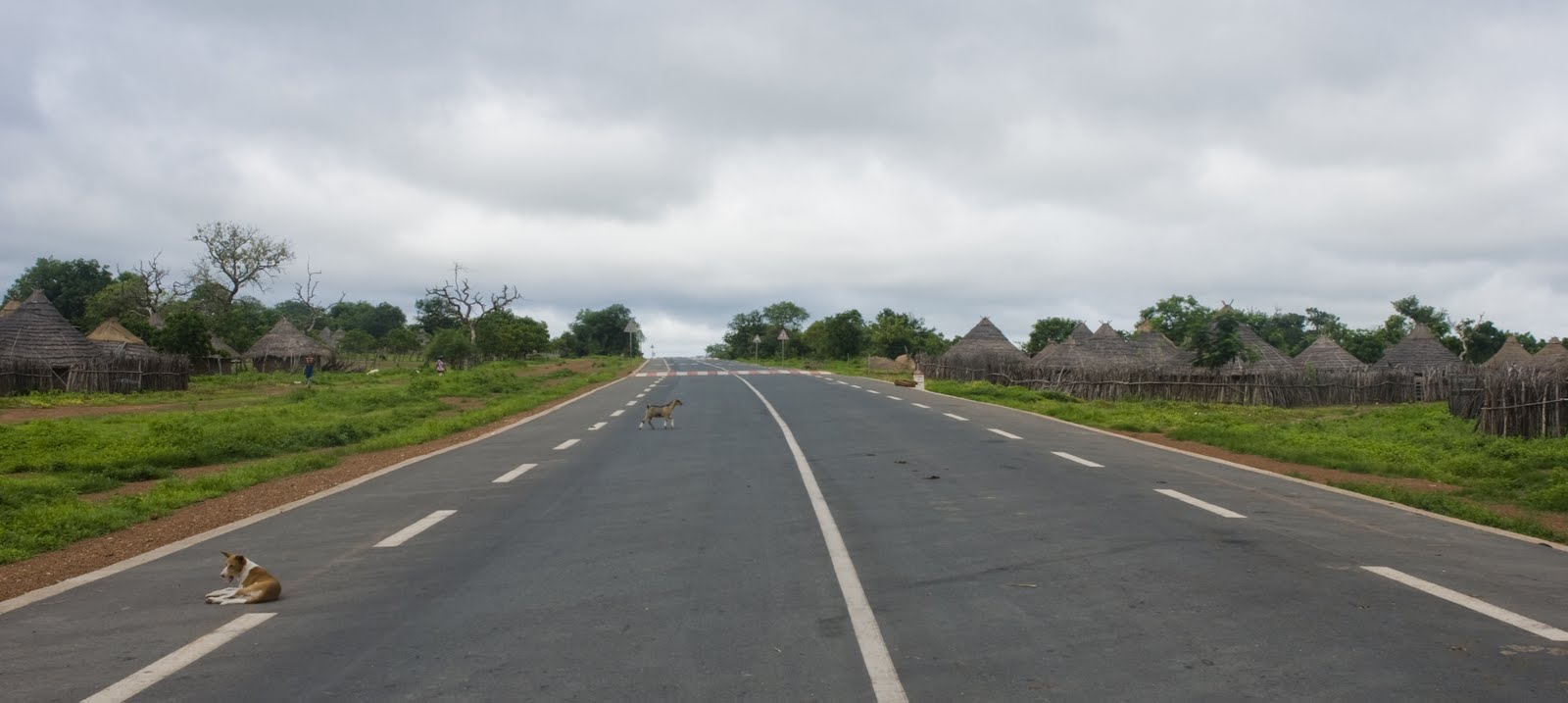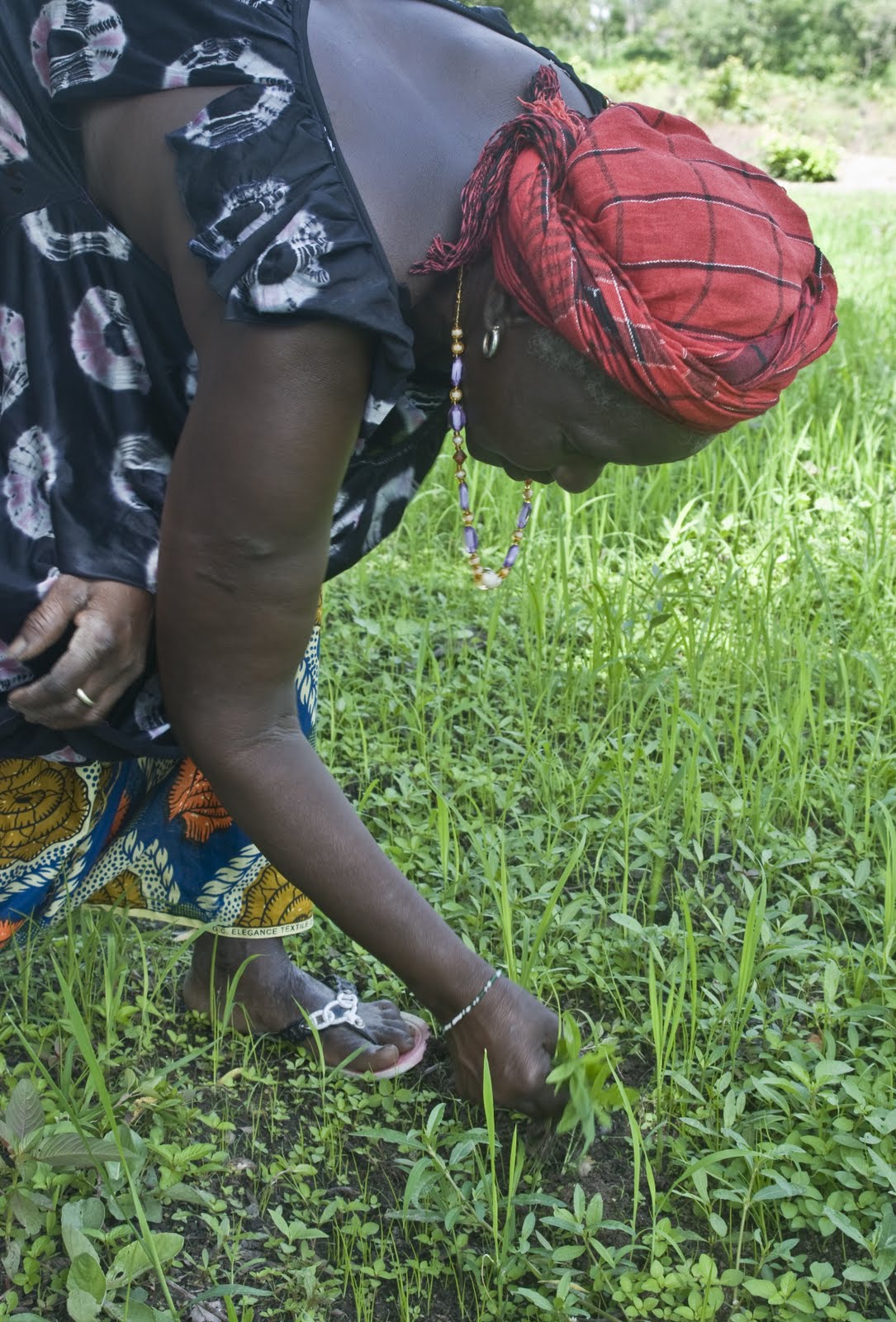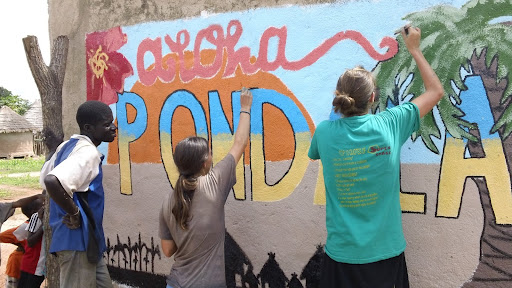Biking is a primary means of transportation for a lot of Peace Corps volunteers. Cars may come and go, but bikes are the only reliable transportation for Peace Corps members, especially for those who live in remote parts of Senegal off the beaten bush path where sept plus' and car rides may are infrequent. This is why no one particularly found it daunting when it was suggested that 17 Peace Corps members, and myself venture on a 25 km (which turns out to be a lie - it was much farther) bike ride through the bush to camp for a night by a waterfall that even most locals have not trekked to.
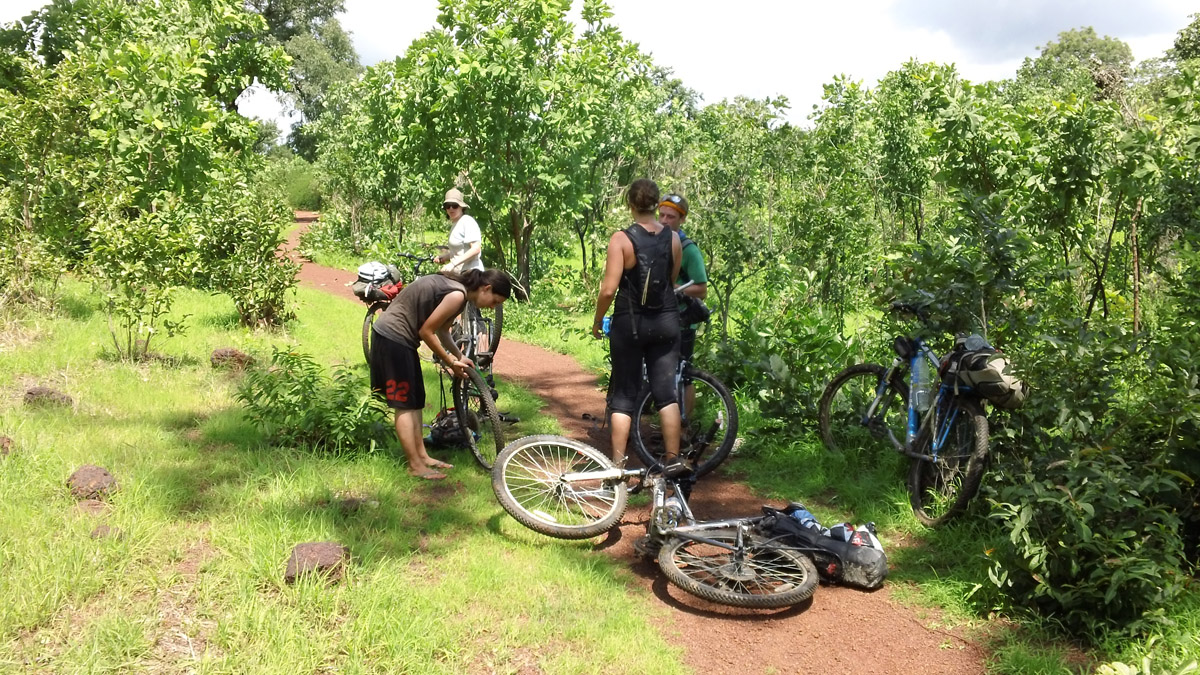 But they continued on their way and we sat for awhile cooling off and splashing in the little river. Fortunately the four of us were a great group to be walking together. We merrily made our way to the village of Oz where some members who spoke Pular were able to ask for the robinet and we were able to fill our bottles with more water. We made small talk with the kind hearted citizens of Oz before we were on our way again.
But they continued on their way and we sat for awhile cooling off and splashing in the little river. Fortunately the four of us were a great group to be walking together. We merrily made our way to the village of Oz where some members who spoke Pular were able to ask for the robinet and we were able to fill our bottles with more water. We made small talk with the kind hearted citizens of Oz before we were on our way again.
The day began bright and early, and we were all packed and ready to go by 8 a.m. Our plan was to take a sept plus (the cars that I mentioned in my earlier post) with 10 people to Dindefelo - the closest town to the waterfall that we could reach by car. To ride from Kedougou to Dindefelo would’ve literally doubled the mileage of the trip, so half of us opted out of that and allowed only the most serious (or seriously deranged) of Peace Corps bikers to bike and meet us there.
Taking a car with 10 people, however, also included 10 bikes and half of our groups supplies! We really had a magical sept plus driver who actually managed to, somewhat, secure 10 bikes on top of each other, on top of a sedan! This was quite a sight to behold, and if it weren’t enough for the locals to be amused by so many tubabs (white people) in a car, they were that much more amused to see the bikes on top! And with all the potholes and flooded out sections of the road I’m still quite uncertain how we made it to Dindefelo without a single mishap.
At Dindefelo we added another member to our team, Lily. Lily is from Spain and has spent the last two years living in Senegal in order to study the behavior of Chimps. We waited in her hut, which, needless to say was covered in pictures of primates and Jane Goodall, for the others to arrive by bike. Finally, by 11 a.m. after everyone had rolled in and our bellies were loaded with omelet sandwiches, and cafe tuba, and our bikes were loaded with all our tents, supplies, 12 chickens, and a bucket of beans, we were ready to set off into the Bush!
First stop, Eric’s Village. He lives on a bush path between Dindefelo and the waterfall, about 7 km in, and trying to keep up with him was no easy task. The path is filled with sand so slippery it feels more like skiing than biking, not to mention the trail is littered with sharp ominous rocks that are there to catch you when you fall. We did have a few casualties along the way but nothing too extreme.
We reached Eric’s hut within an hour, which made me optimistic about the next alleged 18 km left. We continued on and eventually the sand turned into mud that clumped to our tires. The puddles of mud then turned into rivers that we all had to wade across.
Several km later led us to another village deep in the Bush. It was like something the yellow brick road would lead you to in Oz. The whole villages was filled with row after row of planted corn; in fields, in backyards, in side yards, off the path. Though it was rainy season, this rivaled any of the greener sceneries I had see in Senegal so far. The rows of corn literally formed a maze around the village, and we had to lift our bikes over several fences in order to make our way through the village. The people were incredibly friendly too, and helped us along the way.
Biking down one of the villages narrow, corn surrounded, gravelly paths, we had our first real bike accident. One of the girls' tires slipped out on the gravel and, in the process of trying to break her fall with her hand, she managed to carve a small, but deep cut in her hand. The amount of blood it created was overwhelming despite the small size of the wound. Fortunately Peace Corps volunteers are ready for this kind of thing and after swabs of alcohol were used to clean the cut (which was way more painful than the fall it self), and a bit of gauze, we were back on the trail again.
The accident was fortunately minor, but all Peace Corps members are aware of how bad bike accidents can be sometime. Leah is especially so. The year before, a simple attempt of dismounting her bike had led to an accident that snapped her ankle in half. She had to be med-evaced to D.C., where she had surgery! So the fact that we had managed to make it about halfway (or so we thought) through such rough terrain with only a minor cut, was quite an accomplishment!
We stumbled out of the village in Oz and continued on our way. From here the path got even more difficult! Puddles of mud turned into whole fields of it that clumped and stuck to our tires. When it became impossible to pedal, we had to push our bikes trudging through wet hot mud that splashed several inches above our ankles. This is the first of many places on this trip that I may have adopted my intestines' future parasitic friend, and also, my mysterious rash.
Finally, after five hours, a Peace Corps member so dehydrated we thought we would have to send for a moto (aka motorcycle obviously) from a nearby village, ample use of ORS salts (hydration salts) and some more river forging, we finally made it to the fall! And what a sight it was! It was incredibly spectacular and my photos hardly do it a bit of justice. Left out of the photo, after climbing all those rocks to the very top is a pool where the fall feeds into. It’s like a small wave pool from Disney world. You can swim out right under the waterfall, though it feels like a ton of bricks landing on your head.
Our time to swim was cut short by the rain that started about an hour after our arrival. Leah and I frantically set up our tent, but by the time we managed to secure our haphazard rain tarp, the downpour had already caused a minor flood inside. We spent the next hour, four of us huddled in the tiny tent, laughing hysterically as we used cups to literally bale ourselves out! What an experience.
Finally the rain passed, and we set about the difficult task of building a fire with wet logs to cook the 12 raw chickens the boys thought would be a good idea to bring for dinner. Eventually the fire was made and the chicken began to cook. We boiled water from the river to make pasta, and I contributed by filtering, pumping, boiling, adding iodine tablets, and bleach (I think my teeth goth whiter from all the bleach water I drank) to several liters of water to make sure we all could hydrate.
We all went to bed with full bellies and exhausted bodies. Thank goodness because that made it possible to sleep on the wet, hard, ground. In the morning we had bean sandwiches and another swim in the waterfall before it was time to head back. Such an adventure for such a short time at the falls.
It was only about 45 minutes into our inevitable five hour trip back before the greatest of all bike accidents occurred. Fortunately no one was at all injured, but as we attempted to trudge our way through the first muddy swamp, Kate’s tire went flat. Flats our usually no big deal when you bring a patch kit and a pump, like we all had. However, this was not a simple puncture in the tire. The tires nozzle had been pulled right out of the tire in the sticky mud! We were doomed! Half of our group continued the bike trek back to Dindefelo with Eric. Eric biked ahead to his village where he knew he had another tire in his hut, and three of us stayed with Kate and walked.
Apparently, with the amount of rainfall the night before, biking wasn’t much faster than walking, though. After an hour we had caught up to the entire group washing their bikes in a river. The mud was so thick that biking most of the route so far had proved impossible. I’m not surprised since just attempting to push it through the mud was nearly an unachievable feat!
 But they continued on their way and we sat for awhile cooling off and splashing in the little river. Fortunately the four of us were a great group to be walking together. We merrily made our way to the village of Oz where some members who spoke Pular were able to ask for the robinet and we were able to fill our bottles with more water. We made small talk with the kind hearted citizens of Oz before we were on our way again.
But they continued on their way and we sat for awhile cooling off and splashing in the little river. Fortunately the four of us were a great group to be walking together. We merrily made our way to the village of Oz where some members who spoke Pular were able to ask for the robinet and we were able to fill our bottles with more water. We made small talk with the kind hearted citizens of Oz before we were on our way again. Just outside of Oz we met up with Eric who had managed to make it to his hut and race back with the spare! He fixed Kate’s bike, we had a few snacks, and were on our way.
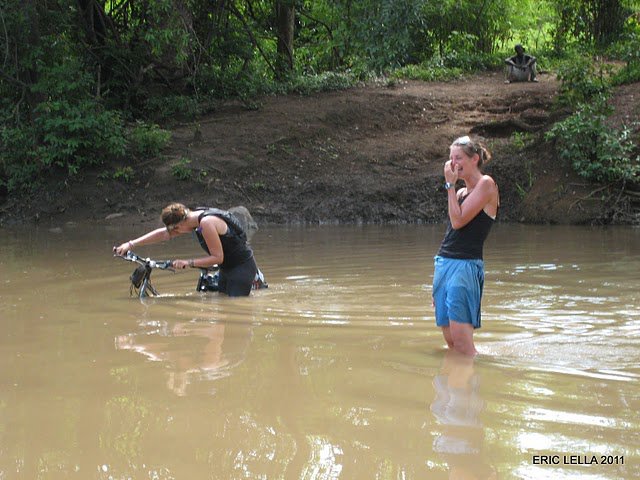 At this point we were all so delirious that everything became funny. Especially our attempt to cross the biggest river of all! I had no strength left in me and one of the other girls had to come back and lift my bike above the waist deep water to prevent all our gear from getting wet. Leah had planned accordingly, and had offered to take all of our gear that was wet from the rain the night before, thus not worrying if it went under the water in this river. In fact she did not even attempt to keep it from going under. It was quite hilarious, when after sweating profusely from the exertion of getting our bikes through, we all looked back to see Leah, merrily wading through the water, with her bike so submerged only the handle bars were showing! I know someone has a picture of this somewhere!
At this point we were all so delirious that everything became funny. Especially our attempt to cross the biggest river of all! I had no strength left in me and one of the other girls had to come back and lift my bike above the waist deep water to prevent all our gear from getting wet. Leah had planned accordingly, and had offered to take all of our gear that was wet from the rain the night before, thus not worrying if it went under the water in this river. In fact she did not even attempt to keep it from going under. It was quite hilarious, when after sweating profusely from the exertion of getting our bikes through, we all looked back to see Leah, merrily wading through the water, with her bike so submerged only the handle bars were showing! I know someone has a picture of this somewhere!
 At this point we were all so delirious that everything became funny. Especially our attempt to cross the biggest river of all! I had no strength left in me and one of the other girls had to come back and lift my bike above the waist deep water to prevent all our gear from getting wet. Leah had planned accordingly, and had offered to take all of our gear that was wet from the rain the night before, thus not worrying if it went under the water in this river. In fact she did not even attempt to keep it from going under. It was quite hilarious, when after sweating profusely from the exertion of getting our bikes through, we all looked back to see Leah, merrily wading through the water, with her bike so submerged only the handle bars were showing! I know someone has a picture of this somewhere!
At this point we were all so delirious that everything became funny. Especially our attempt to cross the biggest river of all! I had no strength left in me and one of the other girls had to come back and lift my bike above the waist deep water to prevent all our gear from getting wet. Leah had planned accordingly, and had offered to take all of our gear that was wet from the rain the night before, thus not worrying if it went under the water in this river. In fact she did not even attempt to keep it from going under. It was quite hilarious, when after sweating profusely from the exertion of getting our bikes through, we all looked back to see Leah, merrily wading through the water, with her bike so submerged only the handle bars were showing! I know someone has a picture of this somewhere!The sight of Dindefelo could not appear more welcoming when we finally strolled up to it’s huts. Lily had a fine pasta meal waiting for our muddy, sweaty selves which we ate with enthusiasm before running to catch the car that would take us back to Kedougou. I don’t think a bucket shower under a canopy of stars has ever felt more nice than the one I took when we got back to the Peace Corps house!
